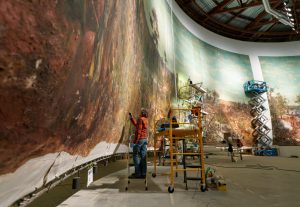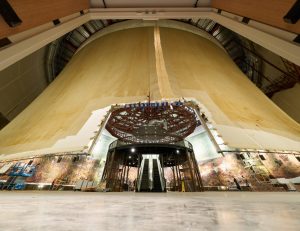Cyclorama: History Comes Full Circle
Courtesy of the Atlanta History Center:
On February 22, 2019, Atlanta History Center opens Cyclorama: The Big Picture, featuring the fully restored cyclorama painting, The Battle of Atlanta. At the centerpiece of this new multimedia experience is a 132-year-old hand-painted work of art that stands 49 feet tall, is (at 371 feet) longer than a football field, and weighs 10,000 pounds. This painting is one of only two cycloramas in the United States – the other being The Battle of Gettysburg cyclorama – making Atlanta home to one of America’s largest historic treasures.

An art conservator at work in the conservation of The Battle of Atlanta cyclorama painting at Atlanta History Center on December 6, 2017
In the 1880s, the gigantic Battle of Atlanta cyclorama painting was an immersive experience – the equivalent of virtual reality today. The painting is a full-color, three-dimensional illusion designed to transport the viewer onto the battlefield. Cycloramas were created as a form of entertainment –- they were the IMAX of their time. The painting was a visual story about the 1864 Battle of Atlanta, but over time it has evolved into a significant artifact that has its own fascinating story. Now, the historical journey of the painting itself is part of the ‘big picture.’
Created at the American Panorama Company in Milwaukee by 17 German artists, The Battle of Atlanta cyclorama took five months to paint before it debuted in Minneapolis in 1886. Painted 22 years after the Battle of Atlanta, the painting originally depicted the battle from a Northern perspective as a heroic Union victory so that it would appeal to Northern audiences. When the painting relocated to Atlanta in 1892, it was slightly modified and advertised as “the only Confederate victory ever painted” to appeal to its new Southern audiences that maintained Confederate sympathies. The 1864 Battle of Atlanta was not a Confederate victory, and changes made in 1892 – such as repainting Confederate captives so they appeared to be Union soldiers captured by Confederates – were re-painted in the 1930s, returning the figures to their original appearance.
In the 127 years that it has been on display in Atlanta, it has been the subject of periodic interpretation. At times, it was seen as a proud symbol of the capital of the New South rising from the ashes left by General William T. Sherman. It has also been criticized as an anachronism meant to glorify the “Lost Cause” of the Confederacy. Perceptions of history, and the painting itself, have depended on the eye of the beholder, as audiences viewed it in different times and places.
“History is messy. And it has a lot to teach us – if we let it. What makes Cyclorama: The Big Picture so cool is the surprise factor of the painting’s history, the how and why it was created, and its various interpretations over time,” said Sheffield Hale, president and CEO of Atlanta History Center. “Facts do not change, but how we understand and view the past varies widely. “We are challenging visitors to explore their own perceptions and misperceptions of history. Facts are facts, but the way we view the past varies widely. Visitors to the cyclorama exhibit will be encouraged to think critically about how art, entertainment and popular culture influence their interpretations of history.”
On July 23, 2014 – one day after the 150th anniversary of the Battle of Atlanta – Mayor Kasim Reed announced a 75-year license agreement with the Atlanta History Center for the relocation, restoration, and conservation of the Battle of Atlanta cyclorama painting, and the Texas locomotive.
The conservation and transfer of Atlanta’s largest painting was orchestrated by a team of Atlanta History Center staff and international experts, working with some of the best minds in the highly specialized field of cyclorama conservation. The team’s two-year process included strength-testing the canvas, documenting the current condition of the paint layers and fiberglass backing, and conducting stabilization conservation efforts needed prior to moving the painting.
After it was carefully separated along two existing seams, the two 5,000-pound sections were successfully rolled around two 45-foot-tall custom-built steel spools. Each spool was lifted out of the Grant Park building by a crane through two 7-foot-square holes cut into the concrete roof. After being loaded on the backs of two flatbed trucks, the painting was trucked to the Atlanta History Center where cranes conducted the delicate operation in reverse, lifting and carefully lowering the scrolls through a 10-foot-square opening in the roof of the 25,000-square-foot custom-built Lloyd and Mary Ann Whitaker Cyclorama Building.
Every step in the extensive two-year restoration process has been choreographed to give contemporary viewers an experience true to the one offered when The Battle of Atlanta cyclorama was created in 1886. The checklist has included:
- re-tensioning the painting to return its correct hyperbolic shape, conveying the intended 3-D effect;
- doing extensive cleaning, repair and touch up to its Belgian linen surface;
- re-creating three missing sections, in the process adding 2,908-square-feet back to the painting in the process, returning it to its original size of 14,952-square-feet;
- erecting a 15-foot-tall stationary platform upon which visitors can view the composition at the horizon line;
- installing a canopy across the ceiling to frame the view;
- and re-creating a 120-foot custom-made diorama landscape, including 128 original restored 1936 soldier figures, ranging from 18 to 42 inches tall.
Visitors will now see The Battle of Atlanta cyclorama painting as it was originally intended to be viewed – an experience no one has witnessed in nearly 100 years.
The Atlanta History Center uses this restored work of art and entertainment, and the history of the painting itself, as a tool to talk about the “big picture.” How can perceptions, memory and interpretations be shaped, or mis-shaped, by a combination of art and entertainment, myth and memory, cultural context, and current events during different eras?
Through exhibitions, rare artifacts, historic images, immersive technology, digital resources, videos, and museum theatre, visitors are encouraged to look critically at a range of Civil War imagery and consider how images and entertainment can influence how we see history. Photography, art, movies, marketing, and media all provoke emotions, and have the ability to produce biased, or incomplete ideas about historical events. They do not always provide the full perspective of events and people.
Using historical evidence, Atlanta History Center highlights the painting through a variety of lenses and experiences designed to offer a 360-degree perspective of our shared history through Atlanta’s largest painting, using Civil War imagery as a tool.
“These shifting viewpoints are precisely what make The Battle of Atlanta cyclorama such a distinctive and important artifact,” said Atlanta History Center Senior Military Historian Gordon Jones. “No other object can so vividly tell the story of how attitudes toward the Civil War have been shaped and reshaped over the past 150 years. In fact, it is the largest single artifact in existence to demonstrate the power of the use and misuse of historical memory.”

View from behind The Battle of Atlanta painting while undergoing conservations at Atlanta History Center on December 6, 2017
Visitors are greeted by an introductory video as they enter Cyclorama: The Big Picture. Two levels of exhibitions detail truths and myths of the Civil War; explore the untold stories of the painting; examine the role movies and visual entertainment have on shaping perspectives of the Civil War; and provide a look at the fleeting entertainment sensation of cycloramas.
Guests enter the painting rotunda through a 7-foot-tall tunnel – passing underneath the diorama – before ascending an escalator to the 15-foot-tall stationary viewing platform. Here visitors immediately experience a full 360-degree view of the painting, enhanced by technology and a 12-minute theatrical, larger-than-life presentation projected onto the painting.
On Saturdays and Sundays, Cyclorama: The Big Picture will feature Meet the Past museum theatre performances, designed to bring history and the stories of everyday individuals to life.
Seeded by a lead legacy gift of $10 million from Atlantans Lloyd and Mary Ann Whitaker, the Atlanta History Center raised $35.8 million for the project, including $10 million for an endowment that will ensure the ongoing care and safe-keeping of The Battle of Atlanta painting and related objects, including the locomotive Texas, over the 75-year license agreement with the City of Atlanta.
Cyclorama: The Big Picture is included in Atlanta History Center’s general admission ticket, which includes full access to all exhibitions, three historic houses, and 33 acres of Goizueta Gardens. Parking is free.
Souper Jenny Café, BRASH Coffee, and Atlanta History Center’s Gift Shop and Bookstore are accessible to all visitors, and do not require tickets to visit.
Tickets for Cyclorama: The Big Picture are now available for purchase online. Due to capacity and the audio and visual presentation on the painting’s viewing platform, timed tickets are required for all show times. We highly recommend securing advance tickets online at AtlantaHistoryCenter.com
ABOUT ATLANTA HISTORY CENTER
Founded in 1926, the Atlanta History Center is an all-inclusive, 33-acre destination featuring the Atlanta History Museum, one of the nation’s largest history museums; including the new Cyclorama: The Big Picture experience; three historic houses — the 1920s Swan House, the 1860s Smith Family Farm, and the 1830s Wood Family Cabin; Goizueta Gardens; the Kenan Research Center; the Grand Overlook event space; a museum shop; a Souper Jenny café; a BRASH coffee shop. In addition, the History Center welcomes visitors to Margaret Mitchell House at Atlanta History Center Midtown.
The Atlanta History Center is open 10 am-5:30 pm Mondays-Saturdays and noon-5:30 pm Sundays (ticket sales until 4:30 pm daily). Parking is free. For more information, please call 404.814.4000 or visit AtlantaHistoryCenter.com.






